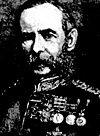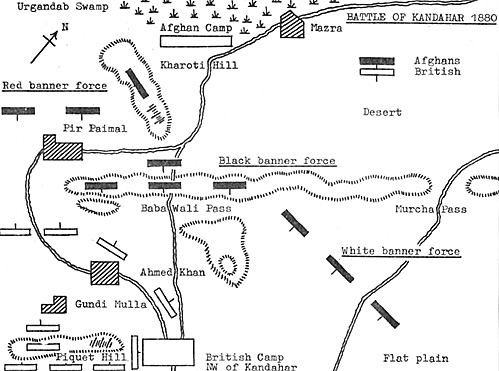 Introduction
Introduction
The main object of the wargame described below was to so if the Ancient Wargames Rules (including recent amendments) of the Wargames Research Group could be used successfully for a late nineteenth century colonial action. These rules were the ones adopted by the Worthing Group for the Ancient game in the 1969 Wargamers' Championship. As little modification as possible was made to the rules; the only major amendment was the essential one of drawing up a line of suitable weapon factors for various Afghan, Indian and British troop types.
Afghans were classed mostly as Class D barbarians, Indiana as Class C regulars, and British forces as Class B regulars. Effective rifle range was set at 2411 and artillery range at 48" (the playing board was 81 by 61). Figure representation was that defined in the rules i.e. one figure represents 20 men. Players were from the midHertfordshire Group - H.J.C.Gerry and E.B.Popkess (British); K.Davies, S.Lovell and E.Skillman (Afghans), with myself as umpire.
Historical Background
British forces have invaded Afghanistan from the North-West Frontier of India, following the killing of the British envoy, Sir Louis Cavagnari, and a small escort from the Corps of Guides at Kabul in September 1879. Several battles near Kabul have subdued the dissident north-eastern tribes but the British have suffered a major defeat in the south at Maiwand.
Encouraged by the outcome of this battle, the southern tribesmen have risen in strength and are investing Kandahar; they have been joined by regular troops of the British-supported Governor of Kandahar province, Shore Ali Khan ' These deserters have brought with them a battery of smooth-bore guns which were a present to Shore Ali Khan from the British Government. However, Sir Frederick Roberts has reached Kandahar with a relief column of reliable troops, after a forced march of twenty days, and has interposed his force between the town and the Afghans' main camp at the village of Mazra (see sketch map). Roberts plans to clear the passes on the Baba Wali Ridge and inflict a severe defeat on the besieging Afghans in order to counteract the effect of the battle of Maiwand.
Initial Orders
The Afghan leader, Ayub Khan, is in command of an army composed of three forces (total 4,140 men) following red, black and white banners. The Khan himself carries the holy green flag of jehad. Initially, the red banner force of 200 elite cavalry and 860 infantry is ordered to hold Pir Paimal against any attack but to act offensively if no strong opposition develops. The black banner force of 200 cavalry and 840 infantry is ordered to line the main Baba Wali Ridge and stop any British advance over the Baba Wali Pass. The white banner force of 260 cavalry, 840 infantry and 640 mounted Ghazis (fanatical irregulars) is ordered to hold the Murcha Pass but to skirmish aggressively if they do not come under pressure. Ayub Khan and his staff (60 men) and artillery (240 men) take up their position on Kharoti Hill, after an abortive stand in the central pass has been curtailed by the accurate fire of the British artillery.
The British Field Force (4,180 men) consists of two formations under the command of Sir Frederick Roberts, V.C. The first formation of Gurkhas, Sikhs, Royal Marine Light Infantry, and a section of Gatling Guns, supported by two squadrons of Dragoon Guards (1,340 bayonets and 160 sabres) is given oriers to advance ex Pir Iraimal and capture the village so that it can be used as a defensive anchor for movement eastwards along the main ridge. The second force of 1,1280 Liao Infantry, Rifles and Highlanders, supported by 280 British Lancers, is ordered to garrison the villages of Ahmed Khan and Gundi Mulla; part of this force is kept in reserve behind Piquet Hill is case of any Afghan breakthrough. Roberts, with his staff (60 men), Royal Engineers (180 men), and artillery (300 men) takes up station on Piquet Hill, which commands a good view of the terrain below the Babe Wali Heights. Reinforcements of 320 Highlanders and 260 Bengal Cavalry are on route from Kandahar, leaving %he garrison dangerously weak; Roberts intends to risk everything to gain a decisive victory.
 The Battle
The Battle
As the Afghans have had time to choose their ground, they occupy the most important heights and a steady dropping fire begins to whittle away the British second force. In particular, the white banner force finds no opposition at the Murcha Pass and rapidly advances to good positions amongst rocky ground overlooking the British camp; the Ghazis dismount and open a damaging fire on the Rifles and Highlanders of the second force, gaining extra accuracy through resting their rifles.
The British assault force can make no headway at all at Pir Paimal, and, in fact, with shouts of "Dean! Dean!" and "Allah-il-Allahl", the Afghans begin to drive in the British forward positions. At this crucial stage, Roberts acts decisively and orders a general advance of the second force while the first force fights a holding action at Pir Paimal, the attempt to turn the Afghan right flank having obviously failed. This marks the turning point of the game; three companies of infantry gain the Bab& Wali Ridge and begin to drive off enemy aniperal whilst below, Gurkhas and the infantry of t1ke second force advance in good order, pausing occasionally to fire steady volleys at the Ghazi skirmishers. This volley fire, coupled with a fierce barrage from the British artillery on Piquet Hill, causes heavy losses amongst the Ghazis and before the British line can come to close terms, one Afghan unit becomes completely domoralised and flees.
The sight of this rout causes a general collapse of the white banner force and the British lancers sweep in to clear this part of the field of all opposition. On the main ridge, having driven off the enemy snipers, the three companies of infantry realise to their horror that they are exposed to the short-range fire of three Afghan batteries and several companies of regular infantry. They break with ever 75% casualties but nevertheless they have done their job and provided a secure flank for the main British advance.
The red banner force at Pir Paimal makes a wild charge at the British holding force but is repulsed and retires to the safety of the village. The battle ends with most of the Afghan cavalry and camelry either routing or refusing to charge and the demoralised infantry suddenly realising they really ought to return to their own villages. Casualties amount to about 25% on both sides but the Afghan forces are no longer in a fit state to continue the fight and the British need little effort to gain the passes on the Babe Wali Ridge. As in the real confrontation, Sir Frederick Roberts has won the decisive victory that he desired.
Results
The Ancient Wargames Rules seemed to work quite effectively for the game - perhaps surprisingly so considering the transition in period from 1000 B.C.-500 A.D. to 1880 A.D. However, there are certain factors, such as move distances, morale and distinction between regulars and barbarians, that remain unchanged no matter what period is considered. As the authors (Phil Barker, Bob O'Brien and Ed Smith) point auto there is no reason why a basic set of rules should net 'be worked out, to the same figure scale, frontage, etc., to cover most military activities from earliest times up to the late nineteenth century.
It is interesting to note that the second edition of the Ancient Wargazes Rules is to be used by Dundee in the Ancient section of this year's Convention and Championship and that a set of adaptions of the Rules for 14/15th century warfare is to be used for the Mediaeval section. Perhaps in the not too distant future, there may even be a Colonial section, using the basic rules with appropriate adaptions.
In the particular game considered here, the rules reproduced very well the aggressiveness of the Afghans so long as the prospects were good and the gradual deterioration when submitted to steady pressure. Rules should allow for the volatile nature of the Afghans, i.e. Class D barbarians, and the element of treachery in their character. Casualties were high - news of a casualty rate of 25% killed and wounded for a British victory would have been counted a disaster back home - but this could be adjusted by appropriate modification of the weapon factors. It is planned to experiment further with the rules using actions from the Zulu War of 1879, the Egyptian War of 1882, and the Mahdist War of 1884-85.
Notes on Troop Types
There are now several ranges of Colonial figures available; the particular figures used in this game were from Garrison (British infantry, British and Indian lancers, and Afghan tribesmen), Scruby (Gurkhas, Sikhs and Afghans), and Miniature Figurines (Highlander and Afghans). Uniform detail for British forces engaged in the Second Afghan War of 1878-80 is fairly accessible (both red and khaki tunics were in use) but painting details for the Afghan types are hard to come by. Very generally, the typical Afghan warrior of this period seems to have worn a turban or bushy turcoman hat I flowing cotton robes (dirty white or brown) with a cummerbund (possibly with pink, red, yellow or green stripes), loose white trousers (pyjamas - hence our word), a sheepskin coat with the hair worn inside (poshteen), and thick boots laced with thongs or sandals with the tip curving upwards (chaplis). He carried a curved knife or sword (tulwar), a cherished rifle or musket, and possibly a small round shield. Standards were small triangular flags carried on a long pole. In physical appearance, most tribesmen were tall and bearded; hair was usually dark but occasionally fair. However, because of the racial admixture in the area - a blend of Aryan, Mauryan, Greek, Mongol, Hun and Persian strains - many different physical types are possible (i.e. anywhere between 20-25mm in height). The Afghans of course have close affinities to their Pathan brothers on the North-West Frontier of India, particularly to the Afridi, Mohmand and Waziri tribes, whose domain extends from the Khyber Pass gout
"Congratulations on your appearance and quotes in last weeks Illustrated London News. Wonderful that the hobby you have done so much to promote should get such a spread.
Of course you are absolutely right about the "fun" aspect. Trouble is that nowadays all hobbies get too sophisticated, and one is expected to be a true expert in electronics, artistry or what have you (C.f. model railways and boats, not to mention photography!)
I like your correspondent who said that "any twit can sit down and get out a (complicated) set of rules". Which is what our Legislators spend their time doing. The real Staff Officer gets it "all on one sheet of paper"I So let us all keep our feet on the ground - the last page of the Illustrated London News article shows up once again the images of taking wargames too seriously. As if those of us who have read our Wells and Young didn't know it already!"
- --James &later (Ex-Major 60th Rifles and 2-d
Gurkhas).
Back to Table of Contents -- Wargamer's Newsletter # 104
To Wargamer's Newsletter List of Issues
To MagWeb Master Magazine List
© Copyright 1970 by Donald Featherstone.
This article appears in MagWeb.com (Magazine Web) on the Internet World Wide Web.
Other articles from military history and related magazines are available at http://www.magweb.com